One of the kitchen sink debates is whether to install your kitchen/bathroom sink as a top mount or an undermount? We won’t blame you; it is a tough choice to make. Both of them have distinctive characteristics, but what is the right choice for you?
Regarding revenue, a report of the kitchen sinks market states that the top mount sinks will hold a substantial share of the global market because of their low cost and compactness.
Whereas, according to a report by global market insights, soon, undermount sinks are also expected to contribute a significant share because of the rising demand from the residential sector.
Thus, both type of sink installation is growing by the day. Yet, it boils down to your cooking preferences, cleaning requirements, countertop space, style, and budget.
In this article, let us study the similarities and dissimilarities of the top mount and undermount sinks. But, let us start with the basics and understand what exactly the two installation types mean.
Jump To : Top Mount Sinks | Undermount Sinks | Comparison
Top Mount Sinks
Kitchen cabinet kings describe top mount sinks as versatile sink since it has easy installation and gives additional support, allowing you to choose any material, regardless of its weight.
On the other hand, even with the silicone caulking, dirt and debris possibly accumulate on the lip, making cleaning a little inconvenient.
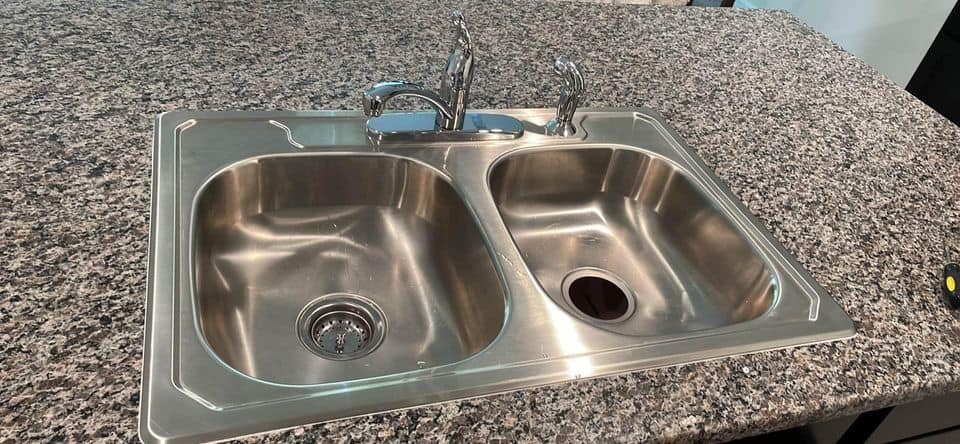
What Are Top Mount Sinks?
Top mount sinks are installed from above into a pre-cut hole in a countertop made of laminate, wood, or solid surface.
They are also familiar with self-rimming, drop-in, or overmount sinks that rest above the countertop and have a lip or rim around the edge. Silicone caulking seals the gap where the rim meets the countertop to keep water and buildup away. In contrast to other sink types, this sink fits into the countertop.
Furthermore, a top mount sink offers a variety of different styles. You have the option of choosing between pressed sinks or hand-made sinks. You need to pick between granite and stainless steel sinks.
- Pressed sinks -In a pressed sink, using a machine, a single sheet of steel is pressed and formed into the shape of the sink. These sinks are relatively thinner and of low cost, but the quality is not up to the mark.
- Hand-made sinks -On the contrary, hand-made sinks are made using laser welding. The manufacturing process of these sinks increases the cost, but it also increases the quality and thickness of the sink.
Advantages
Listed below are the advantages of top-mounted sinks.
Easy installation
One of the best things about top mount sinks, unlike undermount, is that they can fit into and suit any countertop material. In addition, the design frees up base cabinet space allowing you to store and access cleaning supplies right under the sink.
Besides, as the edges rest above the countertop and clamps beneath, they do not demand additional support below the sink. And hence, they are usually faster to install than other sink types.
Bonus Tip -Top-mount sinks can be paired nearly with any countertop, including laminate.
Cost-efficient
The cost of the sink itself, as well as the installation, is less. The price may vary based on the sink material. However, as long as it is a drop-in installation, it is a cost-efficient option.
Besides, there is the ease of cleaning, and you can also re-caulk them as needed for upkeep.
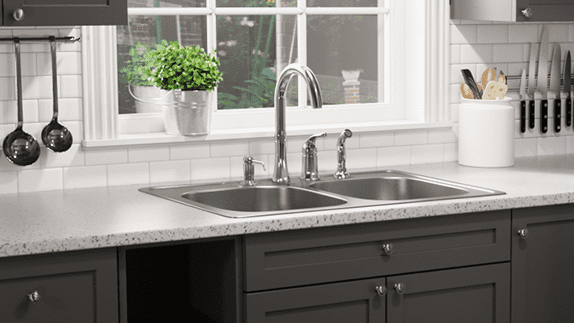
Disadvantages
While offering some advantages, top mount sinks also come with disadvantages.
Demand Extra Countertop Space
Having the rim of the sink extending restricts the countertop space becoming a disadvantage for top-mounted sinks. Apart from that, the countertop is not seamless and may not have a high-end look.
Not so Easy Cleaning
Unlike the undermount sink, the basin of the drop-in sinks is easy to clean.
Furthermore, in top mount sinks, you have a visible and accessible working area making cleaning easier. Therefore, you can care for these areas by cleaning as soon as you witness dirt, gunk, or water.
Yet, you cannot ignore that the small, apparent seam between the lip and the worktop may also accumulate dirt and need cleaning. This seam takes away the ease of cleaning.
NOTE -Top-mount sinks are suitable for any bathroom vanity, kitchen counter, or bar that can practically support its weight.
Undermount Sinks
The undermount sink, unlike top mounts, provide smooth, seamless surfaces. In addition, it perfectly suits the kitchen layout if paired with granite, wood, or other solid surface countertops.
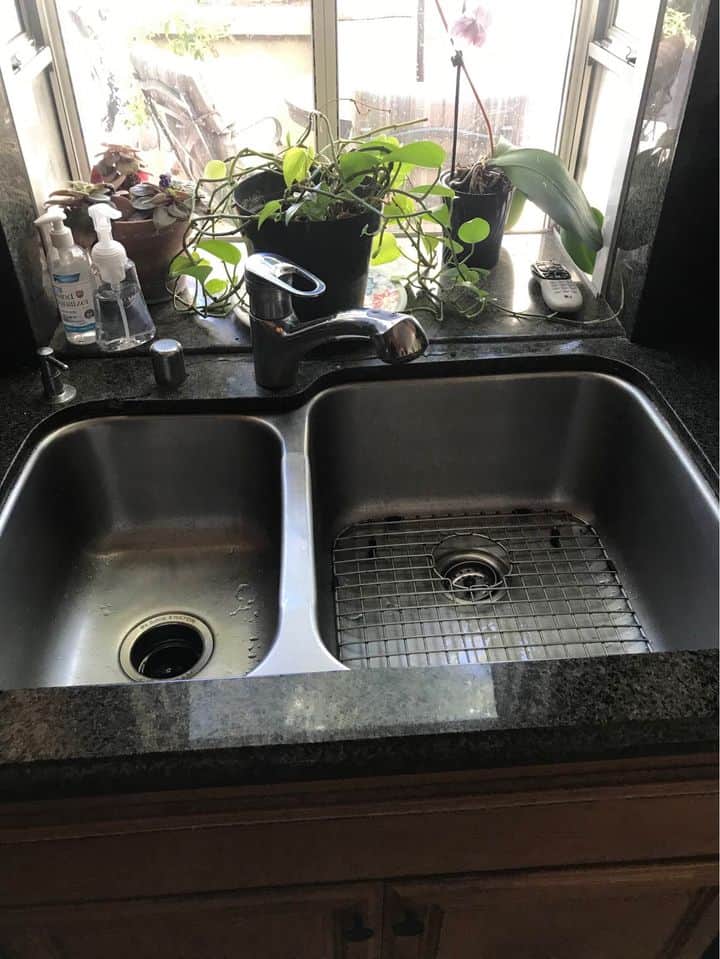
What Are Undermount Sinks?
Undermount sinks, as the name suggests, are sinks that sit underneath the countertop. The installation is such that it reveals the edge of the counter at the hole created for the sink. The sink is then clamped beneath the counter material.
As a result, there is no visible lip between the counter and the sink, but rather, the edges of the sink and countertop will be level. Undermount sink becomes an ideal choice for people who wish to have a sleek, streamlined look in their kitchen.
While installing an undermount sink, you have to also choose between the sink reveal. Sink reveal, precisely, means the portion of the sink visible from below. There are three types available –positive, negative, and zero reveal (or flush mount).
- Positive reveal -In a positive reveal, the rim reveals some portion. Furthermore, this revelation allows the designer considerable leeway when cutting a hole. Due to their ease of cleaning, positive reveals are becoming popular by the day.
- Negative reveal –When the countertop extends slightly beyond the edge of the sink from all sides, it is a negative reveal. Unfortunately, this extended edge is more prone to chipping.
Note -If you don’t clean this extended edge regularly, it can develop mold.
- Zero reveal (or flush mount) – In a zero reveal, the countertop perfectly aligns with the undermount sink. But, this type of reveal becomes an added expense because of the precision it requires while installing. On the contrary, as no edges are revealed, this added expense comes with an additional benefit of ease of cleaning.
The image here will help you get a clear idea of how the reveal looks.
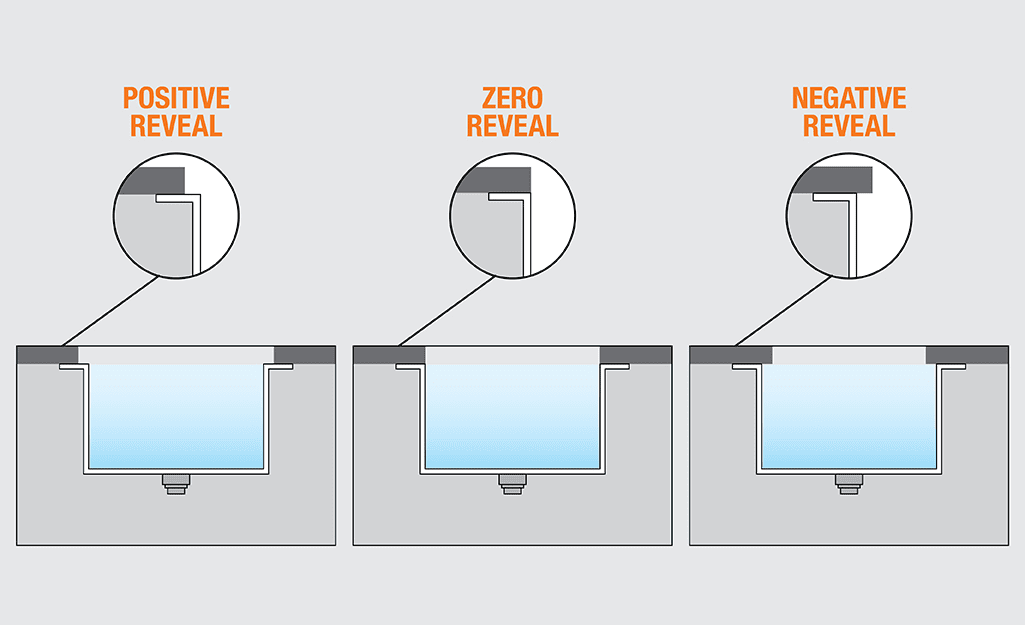
Advantages
Now, let us understand a few advantages undermount sinks carry.
Easy Cleaning
The best part of undermount sinks is that it features a lip below the counter. And hence, it allows water and dirt to be easily wiped into the basin keeping the countertop clean and fresh.
Generally, undermount sinks include integrated drainboards. These drainboards drain the excess water, which keeps the countertop dry and clean.
Diverse and Distinctive Features
Providing a sleek, seamless design complementing the home decor is one reason undermount sinks have started becoming popular. Stainless steel is one such material that can be under-mounted to add beauty to your modern, contemporary kitchen.
Saves Countertop Space
The Undermount sink is beneath the countertop and takes up limited space from the counter in the kitchen. Instead, they provide you with extra counter space to work. This type of sink will not obstruct your counter space in any way.
Moreover, this excess area provides additional storage because the surface is maximized.
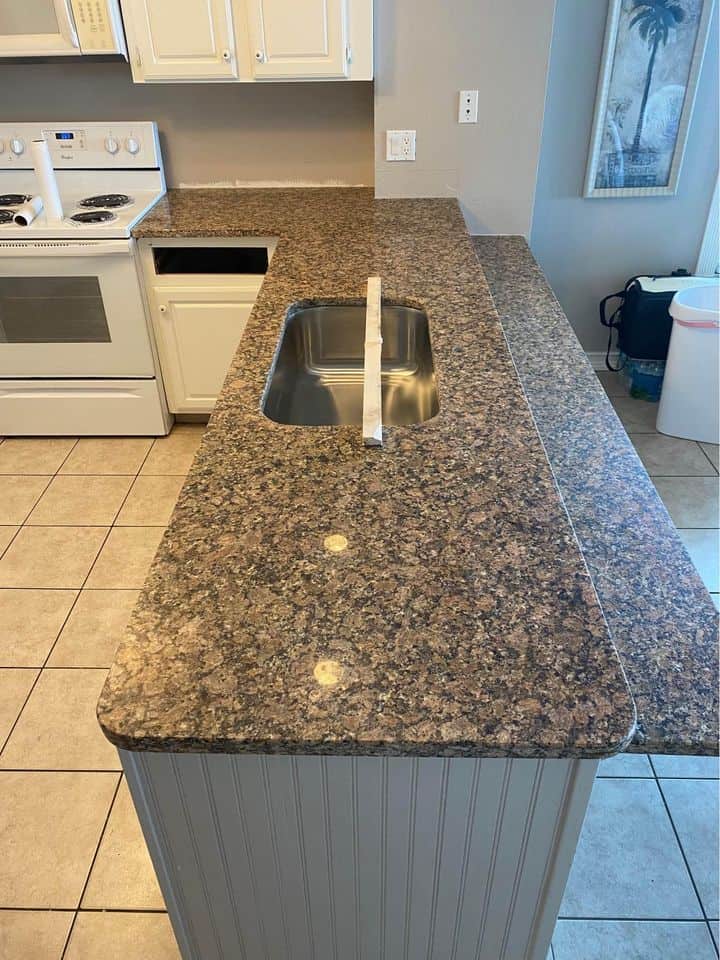
Disadvantages
Some of the disadvantages of undermount sinks have been:
High-Priced
Unlike top mount sinks, undermount sinks are relatively expensive. While budgeting for the undermount sink, you will need a budget for any countertop replacement (if needed).
You will have to hire a professional to install the sink that adds expense. The worker will drill a hole into the countertop to install the sink, making it hard to acquire a new sink in the future, so invest in a high-quality sink the first time to avoid future issues.
Not for Every Countertop
If you’re deciding to install a sink as an undermount sink, make sure you have suitable countertop materials (solid surfaces), high precision work done, and other accessories (if needed).
For undermount sinks, you need a marble, soapstone, or granite countertop. You may have to replace the countertop if you have an unsuitable countertop material and you want to install undermount sinks.
Note -Undermount sinks are not suited for laminate, tile, or wooden countertops.
High Precision Installation
If the sink is installed incorrectly, it may fail. Installation is tricky as the sink is beneath the worktop. Then, the sink and the countertop must be perfectly aligned to create a seamless design.
Tip -Consider having your undermount sink installed by a professional. It will come as an added expense, but you will get a sink that is well constructed.
Difference and Comparison
After reading this far, you might have seen contrasting features of both types of sinks. Let us understand the differences and comparisons these two sinks showcase.
Installation
One of the most contrasting features between the two is installation.
The easiest sink to install is top mount sinks and not undermount sinks. While installing a drop-in sink, you have to ‘drop’ the sink into the pre-cut hole in the countertop. Unlike undermount sinks, you don’t need high-precision to mount a drop-in sink. Along with installation, replacing a top-mounted sink is also easy.
Undermount sinks have troublesome installation. The installation needs to be precise to align the sink edge with the countertop and create a seamless finish.
You can choose top mount over undermount sinks for easy installation.
Distinguishing Features
If you want to show off your kitchen top and layout, you can go for an undermount rather than a top mount sink. Unlike undermount, in a top mount sink, you will not have a sleek, seamless, and streamlined look.
Choose undermount sinks over top mount for complementing your kitchens and homes.
Suitable Countertop
As mentioned above, undermount sinks only work with solid surfaces such as granite, marble, or concrete. Undermount sinks do not work with laminate or wood countertops because they cannot hold the sink’s weight.
On the other hand, top mount sinks go with any countertop materials. You don’t have to replace the countertop to install a drop-in sink, unlike undermount.
Countertop Space
In an undermount sink, you will find a countertop extending to the sink. If you want to use and need as much as possible worktop space, undermount sinks are for you.
Overmount sinks eat up a lot of countertop areas and reduce the workspace.
Therefore, go for undermount than overmount sinks to have enough countertop space.
Care and Cleaning
Care and cleaning are relatively easy for both types of installation types.
For surface cleaning, you can choose undermount over top mount sinks. The reason is that you can directly sweep water, dirt, and debris into the sink. On the contrary, the lip in overmount sinks obstructs from brushing up the dirt into the sink.
However, there is no winner in terms of cleaning and maintaining as both the sinks are easy to clean. Undermount sinks need extra care and maintenance with delicate cleaning, while top mount sinks can withstand rough cleaning.
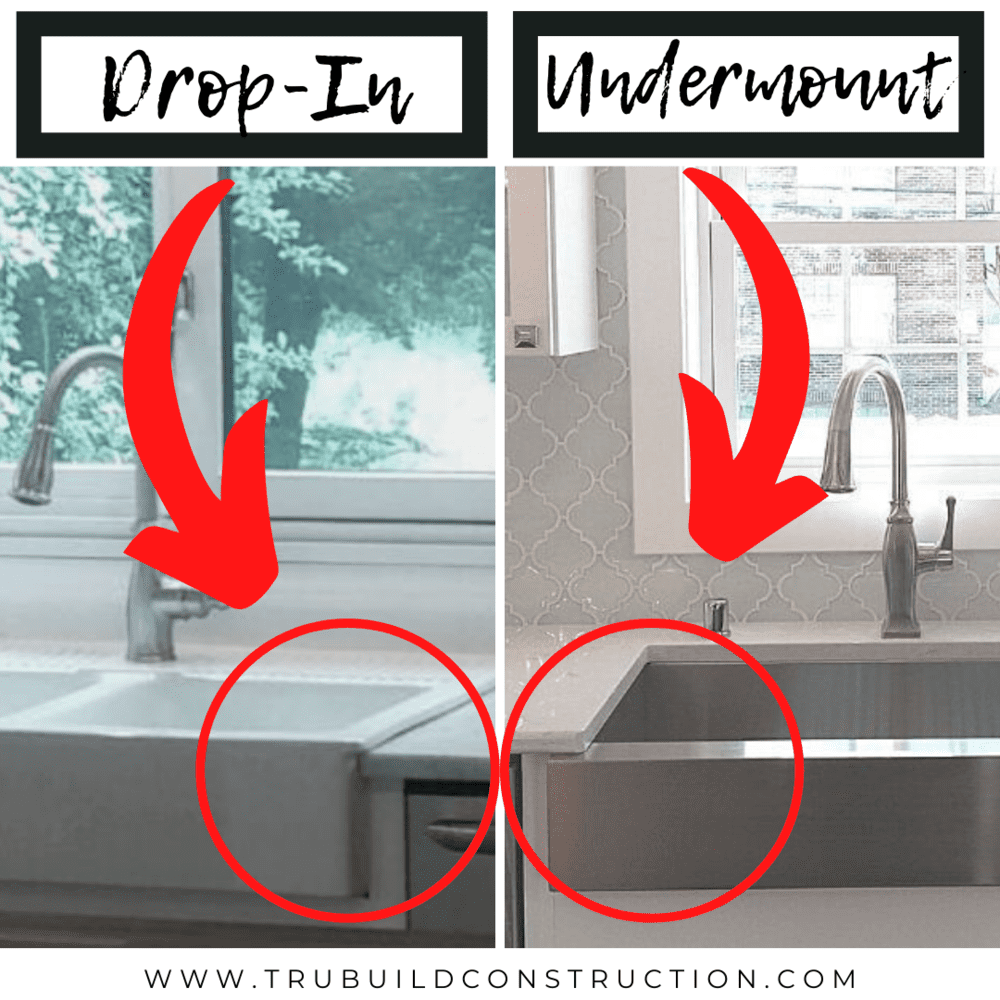
Cost
Top mount sinks are comparatively affordable and cost-effective than undermount. Cost becomes a crucial deciding factor while buying a sink.
The cost of an undermount sink begins at around $70 up to $1000. Most of the sinks cost between $200-$500(excluding installation charges). The high-precision installation can cost you $100-$200. The cost may vary depending upon the material of the sink.
While, contrastingly, top mount sinks start roughly from $70 and can go up to $800. Most of the top mounts cost between $150-$300.
Hence, top mounts are affordable than undermount sinks.
Resale Value
Whether you own a top mount or undermount sink, it will not decide the resale value. Resale value depends upon multiple things such as additions, flooring, rooms, than merely a kitchen or bathroom sink.
But, yes, undermount sinks have a higher resale value than top mount sinks.
Quick Overview
| Top mount sinks | Undermount sinks | |
| Installation | Installed in the pre-cut hole from above the countertop | Installed from beneath the countertop |
| Distinguishing features | Traditional sinks | Sleek, seamless, and streamlined sinks |
| Suitable countertop | Suitable for any countertop material -even laminate | Suitable only for granite, marble, concrete, or soapstone |
| Countertop space | Less countertop space | Enough countertop space |
| Care and cleaning | Easy to clean | Easy to clean (needs delicate and careful cleaning) |
| Cost | Between $70 – $800 (excluding installation charges) | Between $200 -$500 (excluding installation charges) |
| Resale value | Lower than undermount sinks | Higher than top mount sinks |
Now, we have understood the differences, advantages, and disadvantages of both the sinks. However, the decision solely depends on your preferences, taste, and choice.
For some people, the deciding factors might be the price and cleaning. And for others, it might be the look, countertop space, resale value, etc.
Therefore, you can either go top mount sink installation or undermount sink installation, depending on your preferences.
![Ceramic vs Stainless Steel Sink [A Detailed Analysis] Ceramic vs Stainless Steel Sink [A Detailed Analysis]](https://houseadorable.com/wp-content/uploads/2021/12/Ceramic-vs-ss.jpg)
![How Much Does It Cost to Build a Kitchen Island? [Custom Made+DIY] How Much Does It Cost to Build a Kitchen Island? [Custom Made+DIY]](https://houseadorable.com/wp-content/uploads/2022/03/cost-of-kitchen-island.jpg)
![Granite Vs. Marble Vs. Quartz Countertops [12 Differences+Pros & Cons] Granite Vs. Marble Vs. Quartz Countertops [12 Differences+Pros & Cons]](https://houseadorable.com/wp-content/uploads/2022/03/quartz-marble.jpg)
![How Much Weight Can Kitchen Cabinets Hold? [Explained] How Much Weight Can Kitchen Cabinets Hold? [Explained]](https://houseadorable.com/wp-content/uploads/2022/12/img_63ab44a997e44.png)

![Centerset Vs. Widespread Faucets [8 Differences Explained] Centerset Vs. Widespread Faucets [8 Differences Explained]](https://houseadorable.com/wp-content/uploads/2023/03/1_332369605_6500081363358836_8480186754416832788_n-250x250.jpg)
![Pros and Cons of Wall-Mounted Faucets : [Includes Buying Guide] Pros and Cons of Wall-Mounted Faucets : [Includes Buying Guide]](https://houseadorable.com/wp-content/uploads/2023/02/s-l1600-250x250.jpg)
![Kitchen Cabinet Standard Sizes & Dimensions [A Complete Guide] Kitchen Cabinet Standard Sizes & Dimensions [A Complete Guide]](https://houseadorable.com/wp-content/uploads/2022/10/kitchen-cabine.jpg)